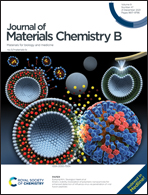Facile synthesis of a three-dimensional hydroxyapatite monolith for protein adsorption†
Abstract
Hydroxyapatite (HA) shows promising applications in the clinical treatment of bone defects owing to its excellent physicochemical properties, such as biocompatibility, bioactivity, and osteoconductivity. However, it is difficult to maintain a porous structure in HA materials because of processing difficulties. In this study, a hard template method was developed to prepare a porous HA monolith with a hierarchical pore structure and high porosity. The cellulose monolith template was prepared from cellulose acetate using a thermally induced phase separation method. The cellulose monoliths were then immersed into the HA slurry to form a cellulose_HA composite monolith, which was converted to an HA monolith by burning in air to remove the cellulose monolith. Owing to the hierarchically porous structure of the cellulose monolith template, the obtained HA monolith demonstrated a hierarchically porous structure. Furthermore, the HA monolith was explored to study the adsorption and release properties of bovine serum albumin (BSA), which indicated that the HA monolith had a high adsorption capacity (388.6 mg g−1) and sustained release from the BSA-loaded HA monolith. Thus, HA monoliths have potential applications in the field of protein purification and biomaterials.



 Please wait while we load your content...
Please wait while we load your content...